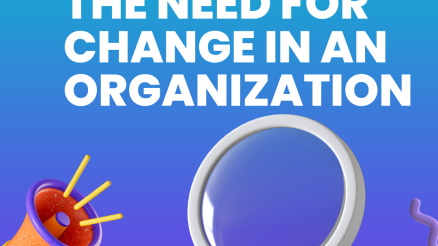Change readiness is the state of an organization’s ability to manage change and uncertainty.
It is a measure of an organization’s preparedness to respond to, and recover from, change events.
Change readiness is a function of an organization’s ability to anticipate change, resist change, adapt to change, and recover from change.
Managers and change leaders use a tool which consists of a set of questions to assess whether organization is ready to implement change or not. By using the change readiness tool, organizations can develop action plans to improve their change management.
Let’s dive into it and see how change readiness assessment tool work.
What is change readiness assessment tool?
A change readiness assessment tool is used to gather information about an organization’s preparation for change and how simple it will be to build an adequate change plan – and, as a result, change initiatives will be more successful.
This diagnostic’s tool is to determine how well-planned a certain organizational transformation endeavor, project, or program has been.
The change readiness tool can help organizations assess their change readiness and develop action plans to improve their change readiness.
The change readiness tool usually consists of four key components:
1) Anticipate change
2) Resist change
3) Adapt to change
4) Recover from change.
Each component includes a set of questions that organizations can use to assess their change readiness. The change readiness tool can help organizations identify areas where they are strong in change readiness and areas where they need improvement.
Why it is important to make assessment of change?
Managing change is always complex and it requires a complete preparation before starting change initiative. Therefore, every manager and change leader must know that whether their organizations are ready and well prepared to take on change.
It’s important because of two reasons:
First, making assessment of change readiness provides an opportunity to identify risks associated with implementation of change.
Second, this kind of assessement gives in-depth analysis of all the component of change and it gives a better picture of entire plan of change.
Using change readiness assessment tool
You can conduct this assessment alone or with other members of organization, such as your steering committee or project team.
You can identify 20 or more than this questions and key areas which reflect preparation on change management. You can ask your colleagues to mark the scale with the corresponding number. The number you circle should represent how well you believe the work has been done so far on that item concerning this change.
Throughout this assessment, keep the accepted definition of the proposed change in mind. Since this is a general assessment tool, the terminology might not be entirely applicable to your organization.
If you believe that something is not pertinent to your situation, either disregard it or consider how you may rewrite it to make it more pertinent.
Before sharing and discussing your results, finish this analysis on your own if you are working on this evaluation with other members of your program, project, or change management team. You can discover that several team members have various points of view.
Exploring these discrepancies can be very helpful in creating a common understanding of the suggestions and identifying the order of priority for taking action.
Example of Change Readiness Assessment Tool
- The proposed change is financially viable and there is strongly possibility of good return on investment
| Not financially viable | 1 | 2 | 3 | 4 | 5 | 6 | 7 | Completely financially viable |
- The cost of proposed change is fully identified and realistically calculated
| Cost not identified | 1 | 2 | 3 | 4 | 5 | 6 | 7 | Cost fully identified |
- The cost of technical disruption or change in the process is fully calculated and identified
| Cost not identified | 1 | 2 | 3 | 4 | 5 | 6 | 7 | Cost fully identified |
- The leaders of proposed change initiative are fully identified
| Leaders not identified | 1 | 2 | 3 | 4 | 5 | 6 | 7 | Leaders are fully identified |
- The vision of change is fully explained by leaders
| Not fully explained | 1 | 2 | 3 | 4 | 5 | 6 | 7 | fully explained |
- The leaders are willing to volunteers for change management.
| Not willing | 1 | 2 | 3 | 4 | 5 | 6 | 7 | fully willing |
- The implementation plan of change management is prepared
| Not fully prepared | 1 | 2 | 3 | 4 | 5 | 6 | 7 | fully prepared |
- The role and responsibilities of different team members are identified
| Not fully identified | 1 | 2 | 3 | 4 | 5 | 6 | 7 | fully identified |
- The risks associated with change initiative are fully identified
| Not fully identified | 1 | 2 | 3 | 4 | 5 | 6 | 7 | fully identified |
- The risk mitigation plan of proposed change is developed
| Not developed | 1 | 2 | 3 | 4 | 5 | 6 | 7 | fully developed |
- The new skills and knowledge required to implement change are identified
| Not fully identified | 1 | 2 | 3 | 4 | 5 | 6 | 7 | fully identified |
- The training plan to build capacity of change team is developed
| Not developed | 1 | 2 | 3 | 4 | 5 | 6 | 7 | fully developed |
- All those who could resist and block proposed change have been identified
| Not fully identified | 1 | 2 | 3 | 4 | 5 | 6 | 7 | fully identified |
- All those who could support change or potential change agent have been identified
| Not fully identified | 1 | 2 | 3 | 4 | 5 | 6 | 7 | fully identified |
- A strategy is prepared to manage resistance towards change
| Not fully prepared | 1 | 2 | 3 | 4 | 5 | 6 | 7 | fully prepared |
- Communication strategy is prepared to explain and present change to team and stakeholders
| Not fully prepared | 1 | 2 | 3 | 4 | 5 | 6 | 7 | fully prepared |
- All communication channels are identified to communicate change
| Not fully identified | 1 | 2 | 3 | 4 | 5 | 6 | 7 | fully identified |
- Criteria for tracking progress and monitoring of activities is if finalized
| Not fully finalized | 1 | 2 | 3 | 4 | 5 | 6 | 7 | fully finalized |
- Methods to measure success of change initiative are identified
| Not fully identified | 1 | 2 | 3 | 4 | 5 | 6 | 7 | fully identified |
- Change management audit checklist is finalized
| Not fully finalized | 1 | 2 | 3 | 4 | 5 | 6 | 7 | fully finalized |
Scoring
You just need to add the numbers you’ve circled to get a result between 20 and 140. If more than one person from your team or group has finished this analysis, add up all of their results, and then figure out the average. What does the final score imply?
20–40 Significant concerns should be felt about the suggested changes.
41–80 An effective change program needs to be developed, which will take a lot of work.
81–100 Even though the idea is well-developed, change management should be improved.
101–140 This change suggestion has been well thought out.
Action
What can we do to address the key issues and roadblocks, and where are they positioned? Use the average item scores for the group or team as a whole to determine which items you scored with five points or fewer. Pick the five things with the lowest scores. Determine their importance, and then come up with suitable solutions to tackle each one in turn to increase readiness:



